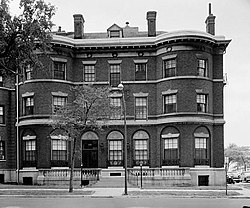
Graceland Cemetery is a large historic garden cemetery located in the north side community area of Uptown, in the city of Chicago, Illinois, United States. Established in 1860, its main entrance is at the intersection of Clark Street and Irving Park Road. Among the cemetery's 121 acres (49 ha) are the burial sites of several well-known Chicagoans.
There are more than 350 places listed on the United States National Register of Historic Places in Chicago, Illinois, including 83 historic districts that may include numerous historic buildings, structures, objects and sites. This total is documented in the tables referenced below. Tables of these listings may be found in the following articles:

The Old Chicago Water Tower District is a historic district along the Magnificent Mile shopping district in the Near North Side community area of Chicago, Illinois. The district is located on both sides of North Michigan Avenue between East Chicago and East Pearson Streets. It includes the Chicago Water Tower, Chicago Avenue Pumping Station, and Chicago Fire Department Fire Station No. 98. All three structures are part of the Chicago Landmark district designated on October 6, 1971. The Water Tower and Pumping Station were jointly added to the National Register of Historic Places on April 23, 1975. In addition the Tower was named an American Water Landmark in 1969. The Water Tower was also one of the few buildings to survive the Great Chicago Fire. The district is the namesake of the nearby Water Tower Place.

The Allan Miller House is a prairie style house in the South Shore neighborhood of Chicago, United States. Located along Paxton Avenue, the home is the only surviving example of Frank Lloyd Wright colleague John S. Van Bergen's work found in Chicago. The house is cast in prairie style and was constructed in 1913. The building has been declared a Chicago Landmark and is listed on the U.S. National Register of Historic Places.

Immaculata High School was an all-girls Catholic high school located in the Lakeview neighborhood of Chicago, Illinois. It was open from 1921 to 1981.

The West Jackson Boulevard District in Chicago, Illinois, also known as West Jackson Historic District, was listed on the National Register of Historic Places in 1978. It was earlier designed as a Chicago Landmark, in 1976, and expanded as Jackson Boulevard District and Extension in 1997. The NRHP district was expanded in 1989 to include one more building, the James H. Pearson House.

The King–Nash House, also known as Patrick J. King House, is a combination of Sullivanesque, Colonial Revival, and Prairie styles house in the East Garfield Park area of Chicago, Illinois, United States. The house was built in 1901 by George W. Maher for Patrick J. King. From 1925 until his death in 1943, it was home to Chicago political boss Patrick Nash.

The Gauler Twin Houses are two specular Prairie style houses located at 5917 and 5921 North Magnolia Avenue in Chicago, Illinois, United States. The houses were built in 1908 by Walter Burley Griffin for John Gauler, a land speculator. They were added to the National Register of Historic Places on June 17, 1977 and designated a Chicago Landmark on June 28, 2000.

The Groesbeck House is an Italianate style house located at 1304 West Washington Boulevard in Chicago, Illinois, United States. The house was built in 1869 by Otis L. Wheelock for Abraham Groesbeck. It was designated a Chicago Landmark on January 12, 1993.
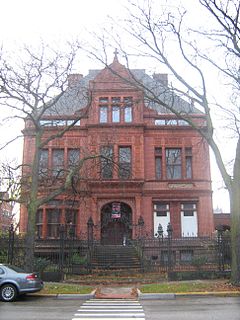
The Kent House, also known as Sydney Kent House or St. James Convent, is a Queen Anne style house located at 2944 South Michigan Avenue in Chicago, Illinois, United States. The house was designed in 1883 by Burnham & Root for Sidney A. Kent. From 1896 to 1906, it was the home of barbed-wire industrialist and robber baron John Warne Gates, better known as "Bet-a-Million" Gates for his gambling excesses.

The Roloson Houses, also known as the Robert W. Roloson Houses, are a group of four adjacent row houses in the Douglas community area of Chicago, Illinois, United States. The houses were designed in 1894 by architect Frank Lloyd Wright (1867-1959) for client Robert W. Roloson (1848-1925). Construction was begun in 1894 and completed in early 1895.

The Wheeler–Kohn House is a Queen Anne and Second Empire Style house in the Near South Side neighborhood of Chicago, Illinois, United States. The house was built in 1870 by Otis L. Wheelock for Calvin Wheeler.

Quinn Chapel AME Church, also known as Quinn Chapel of the A.M.E. Church, houses Chicago's first African-American congregation, formed by seven individuals as a nondenominational prayer group that met in the house of a member in 1844. In 1847, the group organized as a congregation of the African Methodist Episcopal Church, the first independent black denomination in the United States. They named the church for Bishop William Paul Quinn.
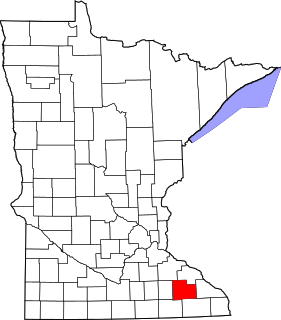
This is a list of the National Register of Historic Places listings in Olmsted County, Minnesota. It is intended to be a complete list of the properties and districts on the National Register of Historic Places in Olmsted County, Minnesota, United States. The locations of National Register properties and districts for which the latitude and longitude coordinates are included below, may be seen in an online map.

This is a list of the National Register of Historic Places listings in Henrico County, Virginia.
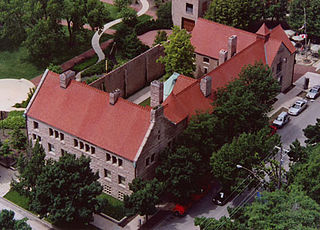
Prairie Avenue is a north–south street on the South Side of Chicago, which historically extended from 16th Street in the Near South Side to the city's southern limits and beyond. The street has a rich history from its origins as a major trail for horseback riders and carriages. During the last three decades of the 19th century, a six-block section of the street served as the residence of many of Chicago's elite families and an additional four-block section was also known for grand homes. The upper six-block section includes part of the historic Prairie Avenue District, which was declared a Chicago Landmark and added to the National Register of Historic Places.

Lathrop Hall is located on the University of Wisconsin-Madison in Madison, Wisconsin. It was added to the National Register of Historic Places in 1985.

Julia C. Lathrop Homes is a Chicago Housing Authority (CHA) public housing project located along the line between the Lincoln Park and North Center neighborhoods on the north side of Chicago, Illinois, United States. It is bordered by the neighborhoods of Bucktown and Roscoe Village. Completed in 1938 by the Public Works Administration, Lathrop Homes was one of the first Chicago public housing projects. Lathrop Homes was placed on the National Register of Historic Places in 2012 and is currently undergoing restoration. Lathrop Homes consists of two-story brick row houses and three- and four-story apartment buildings separated by landscaped courtyards and linked by small archways in a campus-like arrangement. There are a total of 925 units on 35.5 acres of land.
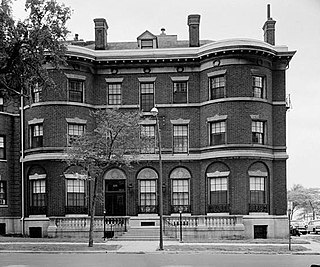
The Fortnightly of Chicago is a woman's club founded in Chicago in 1873 by Kate Newell Doggett. It is the oldest women's association in Chicago.
